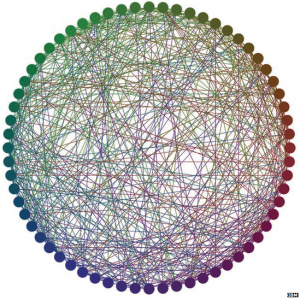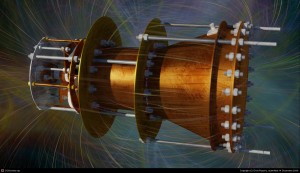Aug
11
2014
 On September 1, 1859, a massive solar flare struck the Earth, resulting in beautiful auroras but also inducing currents in telegraph wires causing them to spark and start fires. Hours earlier amateur astronomer Richard Carrington was observing the sun and noticed large sunspots giving off a brief bright flare. In 1859 the telegraph was about the only electric infrastructure we had. What if a Carrington-type event struck today?
On September 1, 1859, a massive solar flare struck the Earth, resulting in beautiful auroras but also inducing currents in telegraph wires causing them to spark and start fires. Hours earlier amateur astronomer Richard Carrington was observing the sun and noticed large sunspots giving off a brief bright flare. In 1859 the telegraph was about the only electric infrastructure we had. What if a Carrington-type event struck today?
Solar flares result from the complex magnetic fields of the sun. Gas in the sun is so hot the electrons are stripped from the hydrogen, resulting in a plasma. Since plasma is therefore made from ions, it carries an electric charge, and when electric charges move they generate a magnetic field. Magnetic fields further induce electric current.
Sometimes the magnetic fields near the surface of the sun interact in such a way that they give off an explosion of energy, called a solar flare. There is also something called a coronal mass ejection, in which a bubble of hot gas erupts from the sun’s corona in a fashion similar to a solar flare. CMEs and solar flares often occur together, but not always, and their causal relationship is not clear.
Continue Reading »
Aug
08
2014
 Well, a small one, but it’s a start.
Well, a small one, but it’s a start.
IBM announced that they have build a computer chip, dubbed TrueNorth, based on a neuronal architecture. The team published in Science:
Inspired by the brain’s structure, we have developed an efficient, scalable, and flexible non–von Neumann architecture that leverages contemporary silicon technology. To demonstrate, we built a 5.4-billion-transistor chip with 4096 neurosynaptic cores interconnected via an intrachip network that integrates 1 million programmable spiking neurons and 256 million configurable synapses. Chips can be tiled in two dimensions via an interchip communication interface, seamlessly scaling the architecture to a cortexlike sheet of arbitrary size. The architecture is well suited to many applications that use complex neural networks in real time, for example, multiobject detection and classification. With 400-pixel-by-240-pixel video input at 30 frames per second, the chip consumes 63 milliwatts.
Sounds pretty cool. I have written about brain-like computing previously (most recently here). Von-Neumann architecture refers to the traditional basic setup of modern computers, which were described in 1945 by (you guessed it) John von Neumann. This setup has three components: memory, communication, and processing. Information is binary, essentially ones and zeros.
The neuromorphic architecture combines these three elements into one. The neurons are the memory and the processing, and they communicate with each other, similar to a biological brain. Instead of binary code, the neurons spike with a certain frequency. When they send spikes to another neuron, they bring it closer to its threshold for spiking. This is very similar to how the brain functions.
Continue Reading »
Aug
07
2014

Neil deGrasse Tyson stepping into the public GMO debate has raised the profile of this issue, and so I am likely going to return to the issue as new claims surface.
Recently Jeffrey Smith posted a Youtube video in which he directly challenges Tyson on his claim that people should “chill out” about transgenic GM technology. Smith is an anti-GMO activist, founder of the Institute for Responsible Technology, and producer of the anti-GMO documentary, Genetic Roulette — The Gamble of Our Lives.
For further background, Smith attended Maharishi University of Management in the 1980s and was a Natural Law Party member in 1996 and participated in a TM-Sidhi program yogic flying demonstration in Des Moines, Iowa.
His latest anti-GMO effort is full of specific claims I have not previously addressed. He makes an attempt to seem as if his claims are scientific, but upon investigation it quickly becomes clear he is cherry picking studies and then wildly speculating way beyond the evidence. It would take many articles to deconstruct his 20 minute Gish-galloping video, so I will pick out a few prominent claims.
Continue Reading »
Aug
05
2014
 One persistent theme in my writing about scientific topics is that, to optimally serve our own interests, public discourse and decision-making on issues that are highly scientific should be informed by the best evidence and scientific analysis available, not on lies, myths, misconceptions, or raw ideology. I am therefore attracted to topics where I think the myth to fact ratio is particularly high.
One persistent theme in my writing about scientific topics is that, to optimally serve our own interests, public discourse and decision-making on issues that are highly scientific should be informed by the best evidence and scientific analysis available, not on lies, myths, misconceptions, or raw ideology. I am therefore attracted to topics where I think the myth to fact ratio is particularly high.
Genetically modified organisms (GMO) is one such issue. The propaganda machine seems to be way out in front of the more sober voices trying to correct the record and focus the discussion on reality. I also see GMO as the ideological flip side to global warming denial. In the latter case we seen industry and free-market ideologues sowing confusion and misinformation. They also do the ideology shuffle – a dance in which, whenever they are nailed by the facts on one point, they state that their objection is really based on some other point. They never really acknowledge the point, just side-step it.
Anti-GMO activists, in my experience, operate the same way. They have marshaled every possible point they can against GMO, whether or not they are true or valid. When one such point is exposed as a myth, they simply slide over to some other point as their “real” motivation for opposition, but never give any ground.
Continue Reading »
Aug
04
2014
 It is natural for there to be a certain amount of fear and uncertainty surrounding the reported outbreak of a deadly virus. The recent ebola outbreak is the worst in history, with over 800 deaths reported out of over 1,400 infections (case fatality rate so far of 57%).
It is natural for there to be a certain amount of fear and uncertainty surrounding the reported outbreak of a deadly virus. The recent ebola outbreak is the worst in history, with over 800 deaths reported out of over 1,400 infections (case fatality rate so far of 57%).
Crises like these tend to bring out the best and the worst in people. Health care workers are literally risking their lives to contain this outbreak. Meanwhile, charlatans are coming out of the woodwork to exploit the crisis to spread their nonsense.
Ebola was first discovered in 1976. The virus exists in central and western Africa, and outbreaks are usually small, involving isolated villages. The virus can exist in fruit bats, which is the usual reservoir that spreads to humans. Other animals can be the vector, however, including chimpanzees, gorillas, monkeys, forest antelope and porcupines. Once a human infection occurs, however, the virus can spread from person to person.
Continue Reading »
Aug
01
2014
 I’m skeptical. I know, you’re shocked. When you recover, take a look at this article about NASA “validating” an allegedly impossible drive.
I’m skeptical. I know, you’re shocked. When you recover, take a look at this article about NASA “validating” an allegedly impossible drive.
The bottom line is that I just don’t believe it. I could be wrong. I hope I’m wrong. I don’t necessarily think the results of NASA’s test are untrue, just that I don’t think they have “validated” that the propellantless drive is what proponents say it is.
My reaction is identical to the claim made in 2011 that a team of researchers found that neutrinos travel faster than light. I didn’t believe those results either. The researchers were very careful, they rigorously reviewed every aspect of their experiment, and only announced the results when they were confident they ruled out all error. The physics community didn’t believe it, but they did their due diligence. After further analysis, it was found that the results were an error – an artifact introduced in the experimental setup. Initial skepticism was vindicated.
The claims made for a machine that can provide thrust without propellant is as unlikely and at variance with the laws of physics as neutrinos traveling faster than light or free energy machines. Sure, it’s always possible that our understanding of the universe is incomplete in a way that allows for one of these phenomena to be true, but our current understanding calls for extreme initial skepticism. Such a stance has a very good history to support it.
Continue Reading »
 On September 1, 1859, a massive solar flare struck the Earth, resulting in beautiful auroras but also inducing currents in telegraph wires causing them to spark and start fires. Hours earlier amateur astronomer Richard Carrington was observing the sun and noticed large sunspots giving off a brief bright flare. In 1859 the telegraph was about the only electric infrastructure we had. What if a Carrington-type event struck today?
On September 1, 1859, a massive solar flare struck the Earth, resulting in beautiful auroras but also inducing currents in telegraph wires causing them to spark and start fires. Hours earlier amateur astronomer Richard Carrington was observing the sun and noticed large sunspots giving off a brief bright flare. In 1859 the telegraph was about the only electric infrastructure we had. What if a Carrington-type event struck today?










